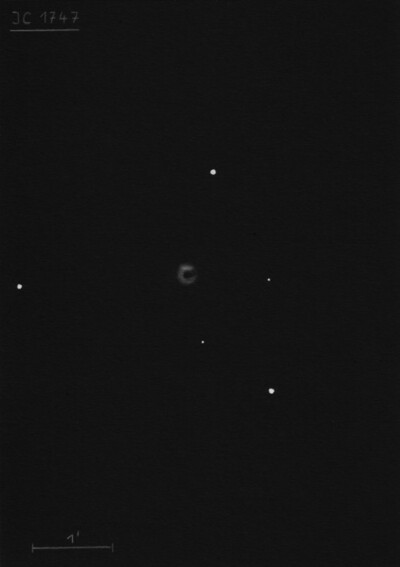
Williamina Fleming discovered IC 1747 = HN 103 in 1905 at Harvard College Observatory, while classifying stars by examining photographic objective-prism spectra. A note in the 1905 Harvard College Observatory Circular No. 98 ("Stars Having Peculiar Spectra") reads "assumed to be the following and southern of two faint and difficult objects, which also appears somewhat hazy. The spectrum consists of a bright band having wavelength of about 5000. Therefore, this object has been assumed to be a gaseous nebula."
Based on Crossley photographs, Heber Curtis (1918) described, "central star about mag 14. Nearly round disk 13" in diameter, with an indistinct ring effect, strongest in the north and south and fading out along an axis in pa 90° [E-W]."
200/250mm - 8" just non-stellar at 125x. Definite disk at 220x and possibly slightly elongated NW-SE. Three mag 11 stars on a line are to the NE.
300/350mm - 13.1" (12/7/85): at 166x without a filter appeared moderately bright, very small, round, about 12" diameter. Takes 360x but no structure is visible. Surrounded by three mag 13 stars 0.8' N, 1.0' SW and 1.3' E of center. Three collinear mag 11 stars oriented SSW-NNE begin 3' NE. Located 30' SE of mag 3.3 Epsilon Cas.
400/500mm - 18" (11/17/08): immediately picked up at 175x as a small bluish disc, ~12" diameter. Situated within a distinctive 20' curving chain of stars that passes through much of the field. Very good contrast gain using an OIII filter. At 450x, the planetary is slightly elongated WNW-ESE, ~15"x12", and weakly annular. At 800x it appeared irregularly brighter along the rim with a knotty structure, particularly along the northern half. Located 30' SE of mag 3.4 Epsilon Cas.
900/1200mm - 48" (10/27/16): at 610x; very bright, small, round, aqua (blue-green) color, 12" diameter. The planetary is annular (though not a high contrast) with a darker center. The rim is unevenly lit, slightly mottled, and brighter along the entire eastern side.
48" (10/23/11): at 375x appeared as a very bright, small, bluish planetary with an irregularly brighter rim, slightly fainter on the west side of the rim. At 488x, this is a very interesting annular planetary with a relatively thick brighter rim that appears clumpy and a dark center. The rim dims, though, on the west side, so the annularity is incomplete. Overall the impression is a thick crescent spanning 270°.
Notes by Steve Gottlieb